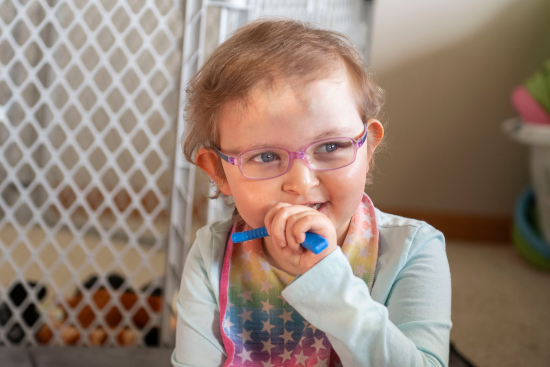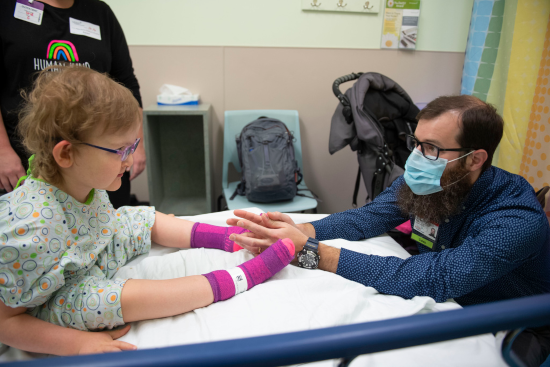
Metabolon Provides Essential Measuring Tool for ‘Miraculous Marley’

Meet Marley Berthoud.
Like any other 6-year-old, she enjoys playing with her toys and idolizes her older brother. However, it took a world of support, dozens of doctor’s visits, and a medical miracle to get here.
Marley, or “Miraculous Marley” as she’s known to her team of clinicians, suffered a brain hemorrhage prior to her birth. Early in life, she was prone to hair loss, muscle tightness, low muscle tone, painful cysts, hearing and visual problems, developmental delays and other neurological deficits.
At Spectrum Health, Helen DeVos Children’s Hospital in Grand Rapids, Michigan, Caleb Bupp, M.D. discovered a mutation in her ODC1 gene. When functioning properly, ODC1 helps balance the nitrogen in the body and create polyamines, which stabilize DNA for cell replication among other functions.
“The ODC1 gene plays an important role in a number of physiological and cell developmental processes including embryo and organ development,” Bupp said in article published by Michigan State University (MSU).

Still, her health team struggled in her diagnosis because this mutation had never been linked to an existing genetic condition. In collaboration with MSU’s pediatric researcher André Bachmann Ph.D., the two named the Bupp-Bachmann syndrome, defined by an overactive ODC1 gene and causing an accumulation of the ornithine decarboxylase (ODC) protein in the body. Since Marley’s diagnosis, four more cases have been identified.
The team curated a treatment plan using the FDA-approved drug Difluoromethylornithine (DFMO), which blocks the activity of the ODC protein. It is effective in treating pediatric neuroblastoma, or cancer in the adrenal glands above the kidneys. DFMO is also approved for African sleeping sickness, hirsutism (excessive male-like hair growth in women) and colon cancer.
The team completed the FDA single-patient Investigational New Drug Application as a compassionate use treatment protocol, which would be the first study in the world to treat a patient with an ODC1 mutation using DFMO. However, they had no quantitative measuring tool to ensure it was working.
Luckily, Bachmann knew of Metabolon.
Measuring up, with NCBiotech support

Morrisville’s Metabolon is a global leader in metabolomics, the study of small molecules. The company was founded in 2000. A decade ago, the North Carolina Biotechnology Center helped support the company’s growth with two years of funding for an on-site industrial intern. Bachmann decided Metabolon’s revolutionary technology could be used to track biochemical alterations of Marley’s condition while her doctors observed phenotypic changes.
At 4 years and eight months of age, Marley began treatment. One month into taking the DFMO oral solution, Marley began growing eyebrows. A month later, scalp hair began appearing. At four months in, she could maintain her posture and sit up by herself. Her body mass index increased from the 25th percentile to the 90th due to muscle bulk. She could feed herself with assistance and use a walker, alongside her improved cognitive abilities.
Doctors could tell her phenotypes were changing, but they needed to know how her body’s metabolism was reacting to the treatment. Various plasma specimens taken throughout treatment were shipped from Michigan to Morrisville to undergo a metabolomic analysis.

“There is not really a regular lab test you can do to look at that, so working with Metabolon gave us that window into Marley’s biochemistry that wouldn’t have been possible otherwise,” Bupp said in the MSU article. “What we saw in the numbers agreed with what we were observing with our eyes. Her body was changing on the inside too.”
In an interview with NCBiotech, Metabolon’s associate director of discovery and translational sciences, Adam Kennedy, Ph.D., explained how small molecules lead to changes in the phenotypes of an individual. Further, the use of metabolomics as a measuring tool was essential in getting a clear picture of her biochemistry, as compared to other “omics.”
“Genomics are great, but if the mutation hasn’t been discovered yet, people don’t think it’s contributing to the phenotype change,” Kennedy said. “People will look at protein levels and see that the protein is there, and therefore, it is not part of the problem. However, it could be that the protein has not been modified yet or modified properly.”
“If the metabolomic profile is misaligned to what we know ‘normal’ looks like, that’s what driving the phenotype or the response to treatment of the phenotype,” Kennedy said.
Metabolon’s industry leadership status stems from its quality proven in accreditations, including Clinical Laboratory Improvement Amendments and College of American Pathologists certifications. According to Kennedy and Elizabeth Romero, Metabolon’s manager of marketing communications, the company has the most extensive library of metabolite entries alongside a separate platform for lipid profiling.

“Metabolon and its leadership in this science is a key contributor to North Carolina’s growing and internationally recognized precision health ecosystem,” said Sara Imhof, Ph.D., senior director of precision health at NCBiotech.
Metabolomics can be applied to other aspects of clinical medicine. When getting a physical exam, most adults have some form of metabolomic testing done, like glucose and ammonia. These panels can be strengthened through measurements Metabolon is making, including better and earlier prediction of liver disease, kidney disease, and cardiac function.
Marley’s story shows, on an individual level, the power of metabolomics in changing lives. Today, she is crawling, scooting, and babbling. She can signal what she wants, hold herself up, and steal toys from her younger brother.
“She has come such a long way,” Bupp said in an article for Spectrum Health. “We all went into this treatment with our eyes wide open. We thought this might work. And now we are seeing scientific discovery happen right in front of us.”
